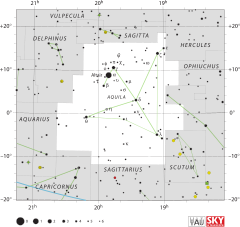| Observation data Epoch J2000 Equinox J2000 | |
|---|---|
| Constellation | Aquila |
| Right ascension | 19h 44m 34.19086s[1] |
| Declination | +13° 18′ 10.0063″[1] |
| Apparent magnitude (V) | 6.25[2] |
| Characteristics | |
| Spectral type | B9 III-IV[3] |
| U−B color index | –0.22[4] |
| B−V color index | –0.04[4] |
| Astrometry | |
| Radial velocity (Rv) | –18.3[5] km/s |
| Proper motion (μ) | RA: +0.561[1] mas/yr Dec.: –9.950[1] mas/yr |
| Parallax (π) | 2.8253 ± 0.0752 mas |
| Distance | 1,150 ± 30 ly (354 ± 9 pc) |
| Absolute magnitude (MV) | −1.17[6] |
| Details | |
| Radius | 3.7[7] R☉ |
| Luminosity | 341[6] L☉ |
| Temperature | 10,814±232[8] K |
| Rotational velocity (v sin i) | 20[9] km/s |
| Age | ~247[10] Myr |
| Other designations | |
| Database references | |
| SIMBAD | data |
Psi Aquilae, Latinized as ψ Aquilae, is the Bayer designation for a star in the equatorial constellation of Aquila. It is a faint star with an apparent visual magnitude of 6.25,[2] which, according to the Bortle Dark-Sky Scale, can be seen with the naked eye in dark rural skies. The orbit of the Earth causes an annual parallax shift of 2.83 mas,[1] which indicates a distance of approximately 1,150 light-years (350 parsecs).
The spectrum of Psi Aquilae matches a stellar classification of B9 III-IV,[3] with the luminosity class of III-IV indicating the spectrum lies part way between that of a subgiant and a giant star. The effective temperature of the star's outer atmosphere is 10,814 K,[8] giving it the blue-white hue of a B-type star.[11] It has nearly four[7] times the radius of the Sun and has a projected rotational velocity of 20 km/s.[9]
References[edit]
- ^ a b c d e Brown, A. G. A.; et al. (Gaia collaboration) (August 2018). "Gaia Data Release 2: Summary of the contents and survey properties". Astronomy & Astrophysics. 616. A1. arXiv:1804.09365. Bibcode:2018A&A...616A...1G. doi:10.1051/0004-6361/201833051. Gaia DR2 record for this source at VizieR.
- ^ a b c "psi Aql -- Star", SIMBAD, Centre de Données astronomiques de Strasbourg, retrieved 2012-07-21.
- ^ a b Cowley, A. (November 1972), "Spectral classification of the bright B8 stars", Astronomical Journal, 77: 750–755, Bibcode:1972AJ.....77..750C, doi:10.1086/111348.
- ^ a b Crawford, D. L. (February 1963), "U, b, v, and Hβ Photometry for the Bright B8- and B9-TYPE Stars", Astrophysical Journal, 137: 530, Bibcode:1963ApJ...137..530C, doi:10.1086/147526.
- ^ Evans, D. S. (June 20–24, 1966), Batten, Alan Henry; Heard, John Frederick (eds.), "The Revision of the General Catalogue of Radial Velocities", Determination of Radial Velocities and their Applications, Proceedings from IAU Symposium no. 30, vol. 30, University of Toronto: International Astronomical Union, p. 57, Bibcode:1967IAUS...30...57E.
- ^ a b Anderson, E.; Francis, Ch. (2012), "XHIP: An extended hipparcos compilation", Astronomy Letters, 38 (5): 331, arXiv:1108.4971, Bibcode:2012AstL...38..331A, doi:10.1134/S1063773712050015, S2CID 119257644.
- ^ a b Pasinetti Fracassini, L. E.; et al. (February 2001), "Catalogue of Apparent Diameters and Absolute Radii of Stars (CADARS) - Third edition - Comments and statistics", Astronomy and Astrophysics, 367 (2): 521–524, arXiv:astro-ph/0012289, Bibcode:2001A&A...367..521P, doi:10.1051/0004-6361:20000451, S2CID 425754.
- ^ a b Paunzen, E.; Schnell, A.; Maitzen, H. M. (December 2005), "An empirical temperature calibration for the Δa photometric system. I. The B-type stars", Astronomy and Astrophysics, 444 (3): 941–946, arXiv:astro-ph/0509049, Bibcode:2005A&A...444..941P, doi:10.1051/0004-6361:20053546, S2CID 119436374.
- ^ a b Abt, Helmut A.; Levato, Hugo; Grosso, Monica (July 2002), "Rotational Velocities of B Stars", The Astrophysical Journal, 573 (1): 359–365, Bibcode:2002ApJ...573..359A, doi:10.1086/340590.
- ^ Gontcharov, G. A. (November 2012), "Spatial distribution and kinematics of OB stars", Astronomy Letters, 38 (11): 694–706, arXiv:1606.09028, Bibcode:2012AstL...38..694G, doi:10.1134/S1063773712110035, S2CID 119108982.
- ^ "The Colour of Stars", Australia Telescope, Outreach and Education, Commonwealth Scientific and Industrial Research Organisation, December 21, 2004, archived from the original on March 18, 2012, retrieved 2012-01-16

Well, that’s interesting to know that Psilotum nudum are known as whisk ferns. Psilotum nudum is the commoner species of the two. While the P. flaccidum is a rare species and is found in the tropical islands. Both the species are usually epiphytic in habit and grow upon tree ferns. These species may also be terrestrial and grow in humus or in the crevices of the rocks.
View the detailed Guide of Psilotum nudum: Detailed Study Of Psilotum Nudum (Whisk Fern), Classification, Anatomy, Reproduction